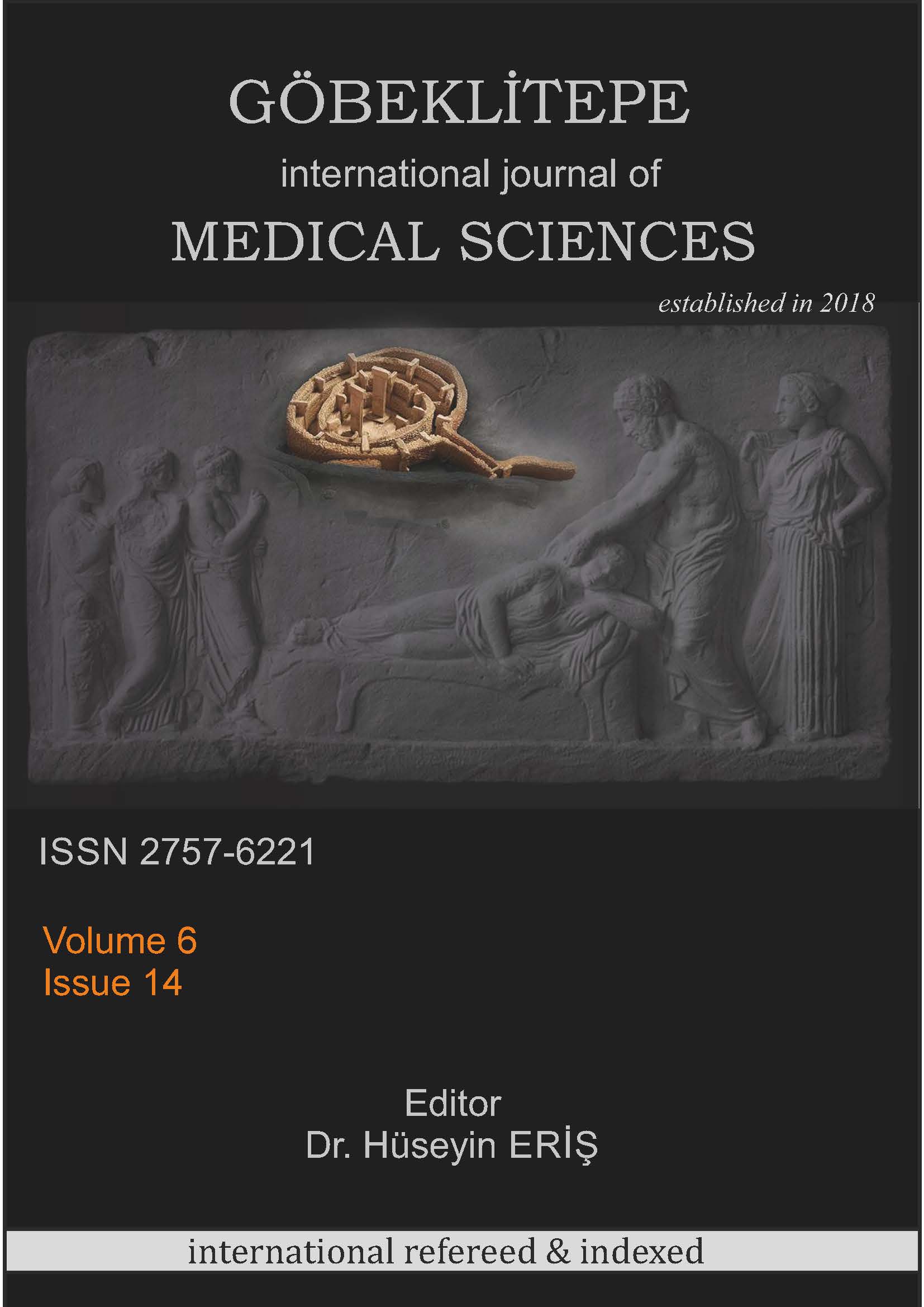SUICIDE PROBABILITY AND RELATED FACTORS AMONG UNIVERSITY STUDENTS İN SANLIURFA
DOI:
https://doi.org/10.55433/gsbd/234Keywords:
Üniversite Öğrencisi, İntihar Olasılığı, ŞanlıurfaAbstract
This study aimed to determine suicide, suicidal ideation and related predisposing factors among university students. The sample of this cross-sectional study included 1,451 students studying at a university in Sanlırfa between October 1, 2022 and January 1, 2023. Data were collected online using a questionnaire prepared by the researchers and the Suicide Probability Scale (SPS). The mean SPS score of the students was 73.53 ± 17.41. Sub-dimension scores were 26.55 ± 7.10 for the hopelessness sub-dimension, 12.19 ± 3.75 for the suicidal ideation sub-dimension, 12.21 ± 3.75 for the hostility sub-dimension and 22.5 ± 5.50 for the negative self-evaluation sub-dimension. Furthermore, it was observed that the total SPS score was higher in those with a monthly income of 20 $ or less, smokers and substance users, those with a psychiatric history, those who had attempted suicide before, those with a history of attempted suicide in their family or environment, those who used psychiatric drugs and those who had been subjected to harassment or abuse before (p ˂ 0.05). Addressing the possibility of suicide among university students and conducting periodic screenings in terms of mental health will contribute to planning preventive mental health services for university students.
References
REFERENCES
Crosby, A., Ortega, L., & Melanson, C. (2011). Self-directed violence surveillance; uniform definitions and recommended data elements, Version 1.0. Atlanta (GA): Centers for Disease Control and Prevention. National Center for Injury Prevention and Control
Posner, K., Melvin, G. A., & Stanley, B. (2007). Identification and monitoring of suicide risk in primary care settings. Primary Psychiatry, 14(12), 50.
Murray, C. J., Aravkin, A. Y., Zheng, P., Abbafati, C., Abbas, K. M., Abbasi-Kangevari, M., ... & Lim, S. S.. (2020). Global burden of 87 risk factors in 204 countries and territories, 1990–2019: a systematic analysis for the Global Burden of Disease Study 2019. The lancet, 396(10258), 1223-1249.
World Health Organization (WHO). Suicide worldwide in 2019. (2021). https://www.who.int/publications/i/item/9789240026643
Turkish Statistical Institute (TÜİK). By Statistical Territorial Units Classification and by gender. (2023). https://data.tuik.gov.tr/Bulten/Index?p=Olum-ve-Olum-Nedeni-Istatistikleri-2020.
Bosson, J. K., Vandello, J. A., & Buckner, C. E. (2019). The psychology of sex and gender. SAGE Publications. Thousand Oaks, California.
The American Foundation for Suicide Prevention (AFSP). Suicide Statics (2021). https://afsp.org/suicide-statistics/
Centers for Disease Control and Prevention (CDC). National Vital Statistics System, Mortality 2018-2021 (2023).. http://wonder.cdc.gov/mcd-icd10-expanded.html
Ültanır, E. (1996). The Necessity of Opening Psychological Counseling and Guidance Centers in Newly Opened Universities, Çağdaş Eğitim Dergisi, 220, 10-14.
Kessler, R. C., Amminger, G. P., Aguilar-Gaxiola, S., Alonso, J., Lee, S., & Ustün, T. B. (2007). Age of onset of mental disorders: a review of recent literature. Current opinion in psychiatry, 20(4), 359–364.
Uchida, C., & Uchida, M. (2017). Characteristics and risk factors for suicide and deaths among college students: A 23-year serial prevalence study of data from 8.2 million Japanese college students. The Journal of clinical psychiatry, 78(4), 2512.
Li, W., Dorstyn, D. S., & Jarmon, E. (2020). Identifying suicide risk among college students: a systematic review. Death studies, 44(7), 450-458.
Atlı, Z., Eskin, M., & Dereboy, Ç. (2009). The Validity and the Reliliability of Suicide Probability Scale (SPS) in Clinical Sample. Turkish Journal of Clinical Psychiatry, 12(3), 111-124
Liu, C.H., Stevens, C., Wong, S.H.M., Yasui, M., & Chen, J.A. (2019). The prevalence and predictors of mental health diagnoses and suicide among U.S. college students: Implications for addressing disparities in service use. Depress Anxiety, 36(1), 8-17.
Wu, R., Zhu, H., Wang, ZJ.., & Jiang, CçL. (2021). A Large Sample Survey of Suicide Risk among University Students in China. BMC Psychiatry, 21(1), 474.
Nock, M.K., Borges, G., Bromet, E.J., Alonso, J., Angermeyer, M., Beautrais, A., Bruffaerts, R., Chiu, W.T., de Girolamo, G., Gluzman, S., de Graaf, R., Gureje, O., Haro, J.M., Huang, Y., Karam, E., Kessler, R.C., Lepine, J.P., Levinson, D., Medina-Mora, M.E., Ono, Y., Posada-Villa, J. &Williams, D. (2008) Cross-national prevalence and risk factors for suicidal ideation, plans and attempts. The British Journal of Psychiatry, 192, 98-105.
Ceyhun, A. G., & Ceyhun, B. (2003). Evaluation of suicide probability in high school and university students. Turkish Journal of Clinical Psychiatry, 6(2), 217-224.
Aslan, B., & Durak, Batıgün, A., (2017). The Mediating Role of Life Goals in the Relationship Between Parent Acceptance/Rejection and Suicide Probability. Turkish Journal of Psychology, 32(79), 77–79.
Jones, L. B., Vereschagin, M., Wang, A. Y., Munthali, R. J., Pei, J., Richardson, C. G., Halli, P., Xie, H., Rush, B., Yatham, L., Gadermann, A. M., Pendakur, K., Prescivalli, A. P., Munro, L., Bruffaerts, R., Auerbach, R. P., Mortier, P., & Vigo, D. V. (2022). Suicidal Ideation Amongst University Students During the COVID-19 Pandemic: Time Trends and Risk Factors. Canadian journal of psychiatry, Epub ahead of print. 7067437221140375.
Sousa, GS., Ramos, BMD., Tonaco, LAB., Reinaldo, AMDS., Pereira, MO., & Botti, NCL. (2021). Factors associated with suicide ideation of healthcare university students. Rev Bras Enferm. 75(3), e20200982. English, Portuguese.
Toprak, S., Cetin, I., Guven, T., Can, G., & Demircan, C. (2011). Self-harm, suicidal ideation and suicide attempts among college students. Psychiatry research, 187(1-2), 140-144.
Aries, E., & Seider, M. (2007). The role of social class in the formation of identity: A study of public and elite private college students. The Journal of Social Psychology, 147(2), 137–157.
Cho, MS. (2020). Use of Alcohol, Tobacco, and Caffeine and Suicide Attempts: Findings From a Nationally Representative Cross-sectional Study. J Prim Care Community Health. 11, 2150132720913720.
Kaslow, N. J., & Marshall Lee, E. D. (2010). Suicidal Behavior Among Youth. The Corsini Encyclopedia of Psychology, 1-3.
Abdu, Z., Hajure, M., & Desalegn, D. (2020). Suicidal behavior and associated factors among students in Mettu University, South West Ethiopia, 2019: an ınstitutional based cross-sectional study. Psychol Res Behav Manag, 3, 233-243.
Gürhan, N., Meriç, M., Kaya, B., Turan, Nd., & Kabataş, Esra. (2018) Comparison of suicide probability and problem solving levels of faculty of medicine and nursing students according to socio-demographic variables Gümüşhane University Journal Of Health Sciences GUSBD, 7(1), 149-155
Gould, M., Greenberg, T., Velting, DM., & Shaffer, D. (2003). Youth suicide risk and preventive interventions: a review of the past 10 years. J Am Acad Child Adolesc Psychiatry, 4, 386-402.
Qaddoura, N., Dardas, LA., & Pan, W.(2022). Psychosocial determinants of adolescent suicide: A national survey. Arch Psychiatr Nurs. 40, 15-24.
O'Neill, S., Mc Lafferty, M., Ennis, E., Lapsley, C., Bjourson, AJ., Armour, C., Murphy, SD., Bunting, B., & Murray, EK. (2018). Socio-demographic, mental health and childhood adversity risk factors for self-harm and suicidal behaviour in College Students in Northern Ireland. Journal of Affective Disorders, 239, 58-65. [JAD9849].
Liu, H., Wang, W., Qi, Y., & Zhang, L. (2022). Suicidal ideation among Chinese survivors of childhood sexual abuse: Associations with rumination and perceived social support, Child Abuse & Neglect, 105420,
Thompson, A. E., & Kaplan, C. A. (1996). Childhood emotional abuse. British Journal of Psychiatry, 168, 143-148.
Downloads
Published
Versions
- 2024-07-02 (2)
- 2023-12-24 (1)
How to Cite
Issue
Section
License
Copyright (c) 2023 Göbeklitepe Sağlık Bilimleri Dergisi

This work is licensed under a Creative Commons Attribution 4.0 International License.




